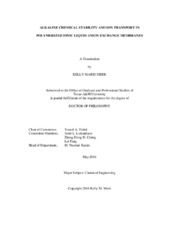| dc.description.abstract | Non-platinum (low-cost), long-lasting, solid-state alkaline fuel cells (AFCs) require anion exchange membranes (AEMs) that have high alkaline chemical stability, high hydroxide ion conductivity, and adequate mechanical properties. In this study, polymerized ionic liquid (PIL) block copolymers were explored as a viable candidate for AFCs. PIL block copolymers are an emerging class of polymers that synergistically combine the benefits of both ionic liquids and block copolymers into one, where the former possesses a unique set of physiochemical properties and the latter self assembles into a range of nanostructures. More importantly, the potential to synthesize a vast array of new block copolymers is almost limitless with numerous IL cations and anions available.
PIL diblock copolymers were first synthesized at various compositions from an imidazolium-based ionic liquid monomer and a non-ionic monomer via reverse addition fragmentation chain transfer polymerization. Hydroxide ion conductivities were higher in the PIL diblock copolymers compared to the analogous PIL homopolymer due to the nanostructured morphology in the PIL diblock copolymers. This demonstrates the high hydroxide ion conductivity of PIL block copolymers.
Numerous PILs were then synthesized with various covalently attached cations (butylimidazolium, butylmethylimidazolium, trimethylammonium, butylpyrrolidinium, trimethylphosphonium) and various backbone/cation pairings (backbones: ethyl methacrylate, undecyl methacrylate, undecyl acrylate, styrene; covalently attached cations: butylimidazolium, trimethylammonium, butylpyrrolidinium) and their alkaline chemical stability was carefully quantified with ^1H NMR spectroscopy. The styrene/butylpyrrolidinium pairing proved to be highly chemically stable, with no degradation in 20 meq of KOH at 60 °C for 168 h.
Considering the high hydroxide conductivities of PIL block copolymers, and the high alkaline chemical stability of the styrene/pyrrolidinium-based PIL, conductivity and chemical stability of a PIL block copolymer (ABCBA pentablock terpolymer) with a styrene/pyrrolidinium-based PIL block was investigated. A high hydroxide conductivity of 43.4 mS cm^-1 at 60 °C in liquid water was achieved and no degradation or loss of conductivity was observed in the membrane after 168 h in 1 M KOH at 60 °C. PIL block copolymers utilizing a styrene/pyrrolidinium backbone/cation pairing in the PIL block represent a promising chemistry for producing highly conductive, chemically stable, robust AEMs for implementation in future solid-state AFCs. | en |


